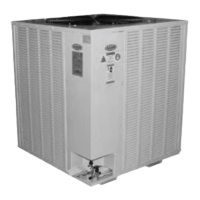Refrigerant Piping
(See back of the manual for refrigerant
piping diagrams.)
General
Piping from the condensing unit to the air
handler is the responsibility of the installing
contractor.
Use only clean type “ACR” copper tubing
that has been joined with high temperature
brazing alloy.
The pipe or line sizes must be selected to
meet the actual installation conditions and
not simply based on the connection sizes at
the condensing unit or air handler.
All CB Series condensing units are provided
with in-line shutoff valves on both the liquid
and suction lines. These should remain
closed until the system is ready for start-up
after installation.
Piping should conform to generally accepted
practices and codes.
Upon completion of piping connection, the
interconnecting piping and air handler
MUST BE evacuated to 500 microns or less;
leak checked and charged with refrigerant.
Determining Refrigerant Line Size
The piping between the condenser and low
side must ensure:
1. Minimum pressure drop, and
2. Continuous oil return, and
3. Prevention of liquid refrigerant slugging,
or carryover
Minimizing the refrigerant line size is
favorable from an economic perspective,
reducing installation costs, and reducing the
potential for leakage. However, as pipe
diameters narrow, pressure-reducing
frictional forces increase.
Excessive suction line pressure drop causes
loss of compressor capacity and increased
power usage resulting in reduced system
efficiency. Excessive pressure drops in the
liquid line can cause the liquid refrigerant to
flash, resulting in faulty Thermal Expansion
Valve (TXV) operation and improper
system performance. In order to operate
efficiently and cost effectively, while
avoiding malfunction, refrigeration systems
must be designed to minimize both cost and
pressure loss.
REFRIGERANT PIPING
This section is for information only
and is not intended to provide all
details required by the designer or
installer of the refrigerant piping
between the condenser or
condensing unit and the air handling
unit. AAON, Inc. is not responsible for
interconnecting refrigerant piping.
Consult ASHRAE Handbook –
Refrigeration and ASME Standards.
REFRIGERANT PIPING
Line sizes must be selected to meet
actual installation conditions, not
simply based on the connection sizes
at the condensing unit or air handling
unit.

